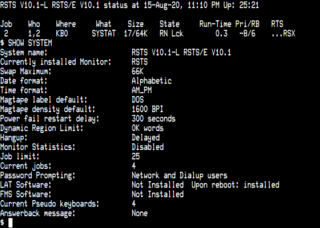Related Research Articles

Digital Equipment Corporation, using the trademark Digital, was a major American company in the computer industry from the 1960s to the 1990s. The company was co-founded by Ken Olsen and Harlan Anderson in 1957. Olsen was president until he was forced to resign in 1992, after the company had gone into precipitous decline.
The Internet protocol suite, commonly known as TCP/IP, is a framework for organizing the set of communication protocols used in the Internet and similar computer networks according to functional criteria. The foundational protocols in the suite are the Transmission Control Protocol (TCP), the User Datagram Protocol (UDP), and the Internet Protocol (IP). Early versions of this networking model were known as the Department of Defense (DoD) model because the research and development were funded by the United States Department of Defense through DARPA.

The Open Systems Interconnection (OSI) model is a reference model from the International Organization for Standardization (ISO) that "provides a common basis for the coordination of standards development for the purpose of systems interconnection." In the OSI reference model, the communications between systems are split into seven different abstraction layers: Physical, Data Link, Network, Transport, Session, Presentation, and Application.
In computer networking, Point-to-Point Protocol (PPP) is a data link layer communication protocol between two routers directly without any host or any other networking in between. It can provide loop detection, authentication, transmission encryption, and data compression.

VAX is a series of computers featuring a 32-bit instruction set architecture (ISA) and virtual memory that was developed and sold by Digital Equipment Corporation (DEC) in the late 20th century. The VAX-11/780, introduced October 25, 1977, was the first of a range of popular and influential computers implementing the VAX ISA. The VAX family was a huge success for DEC, with the last members arriving in the early 1990s. The VAX was succeeded by the DEC Alpha, which included several features from VAX machines to make porting from the VAX easier.

OpenVMS, often referred to as just VMS, is a multi-user, multiprocessing and virtual memory-based operating system. It is designed to support time-sharing, batch processing, transaction processing and workstation applications. Customers using OpenVMS include banks and financial services, hospitals and healthcare, telecommunications operators, network information services, and industrial manufacturers. During the 1990s and 2000s, there were approximately half a million VMS systems in operation worldwide.
Systems Network Architecture (SNA) is IBM's proprietary networking architecture, created in 1974. It is a complete protocol stack for interconnecting computers and their resources. SNA describes formats and protocols but, in itself, is not a piece of software. The implementation of SNA takes the form of various communications packages, most notably Virtual Telecommunications Access Method (VTAM), the mainframe software package for SNA communications.
A virtual private network (VPN) is a mechanism for creating a secure connection between a computing device and a computer network, or between two networks, using an insecure communication medium such as the public Internet.

Ultrix is the brand name of Digital Equipment Corporation's (DEC) discontinued native Unix operating systems for the PDP-11, VAX, MicroVAX and DECstations.
Peripheral Interchange Program (PIP) was a utility to transfer files on and between devices on Digital Equipment Corporation's computers. It was first implemented on the PDP-6 architecture by Harrison "Dit" Morse early in the 1960s. It was subsequently implemented for DEC's operating systems for PDP-10, PDP-11, and PDP-8 architectures. In the 1970s and 1980s Digital Research implemented PIP on CP/M and MP/M.

RSTS is a multi-user time-sharing operating system developed by Digital Equipment Corporation for the PDP-11 series of 16-bit minicomputers. The first version of RSTS was implemented in 1970 by DEC software engineers that developed the TSS-8 time-sharing operating system for the PDP-8. The last version of RSTS was released in September 1992. RSTS-11 and RSTS/E are usually referred to just as "RSTS" and this article will generally use the shorter form. RSTS-11 supports the BASIC programming language, an extended version called BASIC-PLUS, developed under contract by Evans Griffiths & Hart of Boston. Starting with RSTS/E version 5B, DEC added support for additional programming languages by emulating the execution environment of the RT-11 and RSX-11 operating systems.
IPX/SPX stands for Internetwork Packet Exchange/Sequenced Packet Exchange. IPX and SPX are networking protocols used initially on networks using the Novell NetWare operating systems. They also became widely used on networks deploying Microsoft Windows LANS, as they replaced NetWare LANS, but are no longer widely used. IPX/SPX was also widely used prior to and up to Windows XP, which supported the protocols, while later Windows versions do not, and TCP/IP took over for networking.
Local Area Transport (LAT) is a non-routable networking technology developed by Digital Equipment Corporation to provide connection between the DECserver terminal servers and Digital's VAX and Alpha and MIPS host computers via Ethernet, giving communication between those hosts and serial devices such as video terminals and printers. The protocol itself was designed in such a manner as to maximize packet efficiency over Ethernet by bundling multiple characters from multiple ports into a single packet for Ethernet transport.
VAXELN is a discontinued real-time operating system for the VAX family of computers produced by the Digital Equipment Corporation (DEC) of Maynard, Massachusetts.
In computer networking, DECserver initially referred to a highly successful family of asynchronous console server / terminal server / print server products introduced by Digital Equipment Corporation (DEC) and later referred to a class of UNIX-variant application and file server products based upon the MIPS processor. In February 1998, DEC sold its Network Products Business to Cabletron, which then spun out as its own company, Digital Networks, in September 2000.
PATHWORKS was the trade name used by Digital Equipment Corporation of Maynard, Massachusetts for a series of programs that eased the interoperation of Digital's minicomputers and servers with personal computers. It was available for both PC and Mac systems, with support for MS-DOS, OS/2 and Microsoft Windows on the PC. Before it was named PATHWORKS, it was known as PCSA.

The Better Approach to Mobile Ad-hoc Networking (B.A.T.M.A.N.) is a routing protocol for multi-hop mobile ad hoc networks which is under development by the German "Freifunk" community and intended to replace the Optimized Link State Routing Protocol (OLSR) as OLSR did not meet the performance requirements of large-scale mesh deployments.
Distributed Overlay Virtual Ethernet (DOVE) is a tunneling and virtualization technology for computer networks, created and backed by IBM. DOVE allows creation of network virtualization layers for deploying, controlling, and managing multiple independent and isolated network applications over a shared physical network infrastructure.
The History of the Berkeley Software Distribution begins in the 1970s.

The Sniffer was a computer network packet and protocol analyzer developed and first sold in 1986 by Network General Corporation of Mountain View, CA. By 1994 the Sniffer had become the market leader in high-end protocol analyzers. According to SEC 10-K filings and corporate annual reports, between 1986 and March 1997 about $933M worth of Sniffers and related products and services had been sold as tools for network managers and developers.
References
- ↑ James M. Moran; Brian J. Edwards (February 1984). "Giving DECnet a LAN". Hardcopy . pp. 62–65.
- ↑ "SYSTEMS STRATEGIES". The New York Times . May 13, 1992.
DECnet/SNA gateway solution
- ↑ "DECnet for Linux". SourceForge. Archived from the original on October 4, 2009. Retrieved June 26, 2018.
- ↑ Caulfield, Christine (February 18, 2010). "Orphan DECnet". Linux Kernel ChangeLog 2.6.33. Archived from the original on August 11, 2011. Retrieved June 26, 2018.
- ↑ "kernel/git/torvalds/linux.git - Linux kernel source tree". git.kernel.org. Retrieved August 3, 2022.
- ↑ "kernel/git/torvalds/linux.git - Linux kernel source tree". git.kernel.org. Retrieved October 6, 2023.
- ↑ Digital Equipment Corporation (1978). "Nineteen Fifty-Seven to the Present" (PDF). Computer History Museum. p. 53. Archived from the original (PDF) on December 21, 2013. Retrieved June 26, 2018.
- ↑ "Software Product Description: DECnet-VAX, Version 1" (PDF). DEC. September 1978. Retrieved May 23, 2023.
- ↑ "Introduction to DECnet (Phase III)" (PDF). May 22, 1982.
- ↑ "Overview of DECnet" (PDF).
- ↑ "The DECnet Phase IV Specifications".
- ↑ James Martin; Joel Leben (1992). DECnet Phase V: An OSI Implementation Network. ISBN 978-0-1320-2987-2.
- ↑ Erik E. Fair (January 5, 1984). Re: The Plethora of Networks. Usenet fa.human-nets. Retrieved August 19, 2018. Archived March 14, 2016, at the Wayback Machine
- ↑ Network World (September 7, 1987), p.4. DECworld network links hotels, ocean liners. Retrieved August 19, 2018.
- ↑ Network World (August 6, 1990), p.1. DEC shares early lessons on DECnet V. Retrieved August 19, 2018.
- 1 2 L. Stuart Vance (1990). The User's Directory of Computer Networks, The DECnet Internet. Retrieved August 19, 2018.
- ↑ L. Stuart Vance (1990). The User's Directory of Computer Networks, The DECnet Internet (Publisher Summary). Retrieved August 19, 2018.
- ↑ NASA Technical Reports Server (August 1, 1989). Space physics analysis network node directory (The Yellow Pages): Fourth edition. Retrieved August 19, 2018. Archived March 8, 2021, at the Wayback Machine
- ↑ The DECSYSTEM-20 at Columbia University 1977-1988. Archived from the original on July 7, 2022. Retrieved August 3, 2022.
- ↑ Computing at Columbia Timeline. Archived from the original on July 6, 2022. Retrieved August 3, 2022.
- ↑ HECnet - The hobbyist DECnet. Retrieved January 24, 2022.
- ↑ Retro DECnet. Retrieved August 19, 2018.
General references
- Carl Malamud, Analyzing DECnet/OSI Phase V. Van Hostrand Reinhold, 1991. ISBN 0-442-00375-7.
- James Martin, Joe Leben, DECnet Phase V: An OSI Implementation. Digital Press, 1992. ISBN 1-55580-769-0.
- DECnet-Plus manuals for OpenVMS are available at http://www.hp.com/go/openvms/doc/
- DECnet Phase IV OpenVMS manuals for DECnet Phase IV; these Phase IV manuals are archived on OpenVMS Freeware V5.0 distribution, at http://www.hp.com/go/openvms/freeware and other sites.
- DECnet Phase IV architecture manuals (including DDCMP, MOP, NICE, NSP, DAP, CTERM, routing); at https://web.archive.org/web/20140221225835/http://h71000.www7.hp.com/wizard/decnet/ (the originals are mirrored at DECnet for Linux).
- Cisco documentation of DECnet, at http://docwiki.cisco.com/wiki/DECnet Archived January 10, 2017, at the Wayback Machine